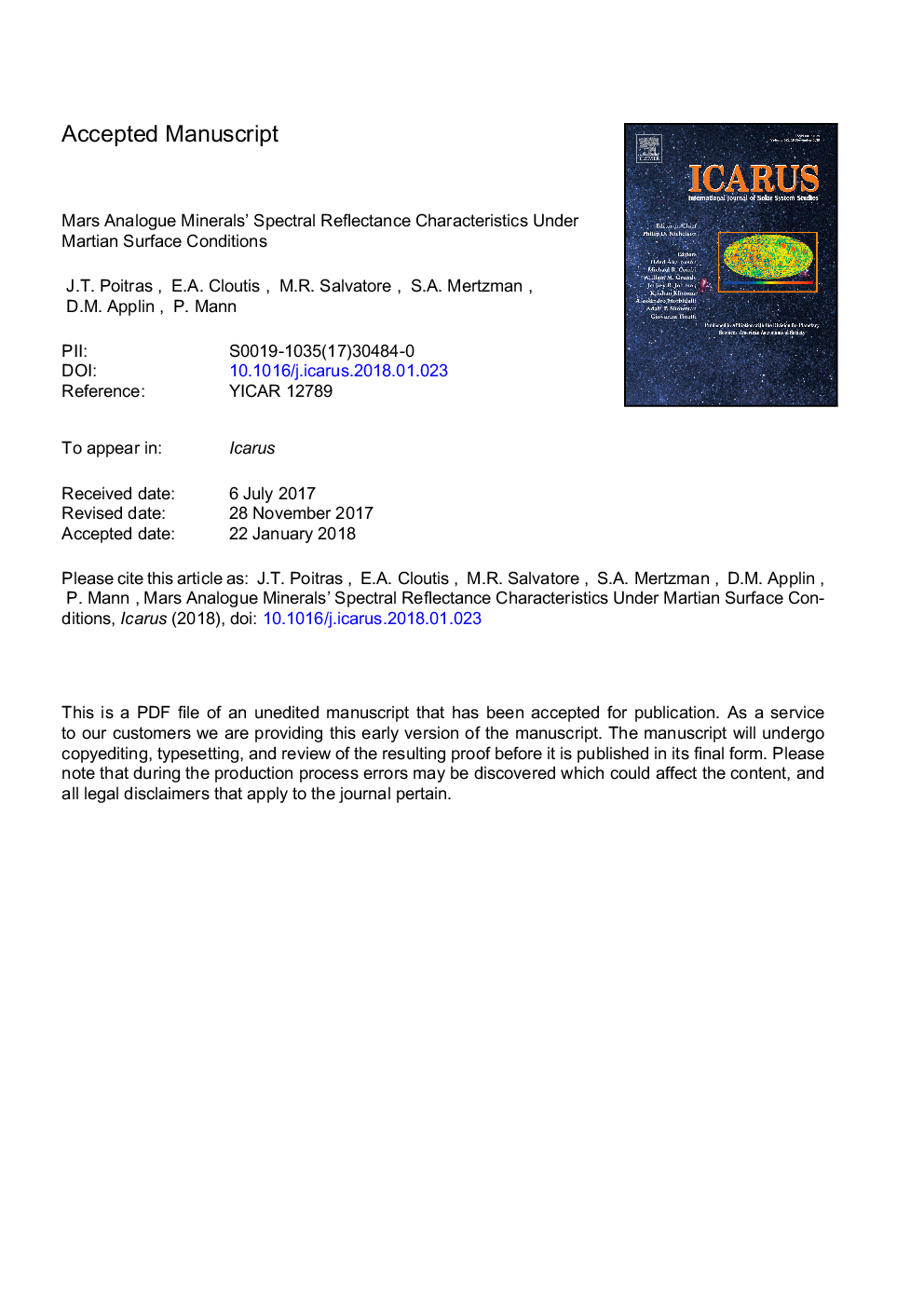| کد مقاله | کد نشریه | سال انتشار | مقاله انگلیسی | نسخه تمام متن |
|---|---|---|---|---|
| 8134244 | 1523485 | 2018 | 64 صفحه PDF | دانلود رایگان |
عنوان انگلیسی مقاله ISI
Mars analog minerals' spectral reflectance characteristics under Martian surface conditions
ترجمه فارسی عنوان
ویژگی های بازتابی طیفی مواد معدنی مریخ تحت شرایط سطح مریخ
دانلود مقاله + سفارش ترجمه
دانلود مقاله ISI انگلیسی
رایگان برای ایرانیان
کلمات کلیدی
طیف سنجی بازتابی، سیلیکا، کربنات، سولفات، اشعه ماوراء بنفش مریخ،
موضوعات مرتبط
مهندسی و علوم پایه
علوم زمین و سیارات
علوم فضا و نجوم
چکیده انگلیسی
We investigated the spectral reflectance properties of minerals under a simulated Martian environment. Twenty-eight different hydrated or hydroxylated phases of carbonates, sulfates, and silica minerals were selected based on past detection on Mars through spectral remote sensing data. Samples were ground and dry sieved to <45â¯Âµm grain size and characterized by XRD before and after 133 days inside a simulated Martian surface environment (pressure 5â¯Torr and CO2 fed). Reflectance spectra from 0.35 to 4â¯Âµm were taken periodically through a sapphire (0.35-2.5â¯Âµm) and zinc selenide (2.5-4â¯Âµm) window over a 133-day period. Mineral stability on the Martian surface was assessed through changes in spectral characteristics. Results indicate that the hydrated carbonates studied would be stable on the surface of Mars, only losing adsorbed H2O while maintaining their diagnostic spectral features. Sulfates were less stable, often with shifts in the band position of the SO, Fe, and OH absorption features. Silicas displayed spectral shifts related to SiOH and hydration state of the mineral surface, while diagnostic bands for quartz were stable. Previous detection of carbonate minerals based on 2.3-2.5â¯Âµm and 3.4-3.9â¯Âµm features appears to be consistent with our results. Sulfate mineral detection is more questionable since there can be shifts in band position related to SO4. The loss of the 0.43â¯Âµm Fe3+ band in many of the sulfates indicate that there are fewer potential candidates for Fe3+ sulfates to permanently exist on the Martian surface based on this band. The gypsum sample changed phase to basanite during desiccation as demonstrated by both reflectance and XRD. Silica on Mars has been detected using band depth ratio at 1.91 and 1.96â¯Âµm and band minimum position of the 1.4â¯Âµm feature, and the properties are also used to determine their age. This technique continues to be useful for positive silica identifications, however, silica age appears to be less consistent with our laboratory data. These results will be useful in spectral libraries for characterizing Martian remote sensed data.
ناشر
Database: Elsevier - ScienceDirect (ساینس دایرکت)
Journal: Icarus - Volume 306, 15 May 2018, Pages 50-73
Journal: Icarus - Volume 306, 15 May 2018, Pages 50-73
نویسندگان
J.T. Poitras, E.A. Cloutis, M.R. Salvatore, S.A. Mertzman, D.M. Applin, P. Mann,
